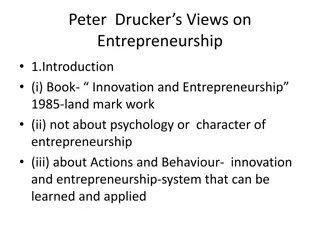
Understanding Entrepreneurship in Modern Markets
Explore the evolution and significance of entrepreneurship in modern markets, from historical perspectives to contemporary roles. Learn how entrepreneurs drive economic development and create value through innovative ventures, taking risks to seek rewards in a dynamic business landscape.
Download Presentation

Please find below an Image/Link to download the presentation.
The content on the website is provided AS IS for your information and personal use only. It may not be sold, licensed, or shared on other websites without obtaining consent from the author. If you encounter any issues during the download, it is possible that the publisher has removed the file from their server.
You are allowed to download the files provided on this website for personal or commercial use, subject to the condition that they are used lawfully. All files are the property of their respective owners.
The content on the website is provided AS IS for your information and personal use only. It may not be sold, licensed, or shared on other websites without obtaining consent from the author.
E N D
Presentation Transcript
Erasmus+, Key Action 2: Strategic partnership PROJECT NUMBER: 2015-1-FR01-KA203-015261 IO1: Open Online Courses on Social Entrepreneurship Learning Material Entrepreneurship
Introduction to Entrepreneurship Entrepreneurship has become increasingly important for businesses of all sizes around the world. It opens new opportunities and possibilities for the businesses to create values for themselves and for the society at large. Despite its popularity, studies suggest that the scope of entrepreneurship remains unknown, and therefore the prospects of entrepreneurial activities remains not fully realised. This chapter highlights some aspects concerning the concept of entrepreneur, entrepreneurship, entrepreneurial process and finally the entrepreneurship opportunities and challenges. 2
Introduction to Entrepreneurship Entrepreneurs have always been present, however their behavioural patterns were different in different periods of time. The word entrepreneur was derived from the French word entreprendre , which means to undertake (Kuratko, 2016). The usage of the term entrepreneur can be traced from 1755, wherein an entrepreneur was described to buy the country produce from those who bring it or to order it to be brought on their account. They pay a certain price to resell wholesale or retail at an uncertain price (Cantillon, 1931, p.51; Hamilton & Harper, 1994) Entrepreneur from the very beginning, was principally an independent speculator of the commodity (Hamilton & Harper, 1994) 3
Introduction to Entrepreneurship In the modern day markets, the term entrepreneur has been closely linked with economic development. An economic development can emerge due to several reasons, which includes: (a) the launch of new source of procurement for raw materials or materials (b) the introduction of a new production mechanism (c) the introduction of a new quality of product, or a novel product (d) the opening of new market (e) the re-organisation of a business. The management of all these aspects are carried by an enterprise, and the people whose functions are to carry out these activities are called entrepreneurs (Bull & Willard, 1993) 4
Introduction to Entrepreneurship take risks whilst seeking rewards for their ventures and efforts (Kuratko, 2016) innovators or developers who identify and capture opportunities transform the opportunities into merchandisable concepts In contemporary markets, entrepreneur act as: create value through multiple stakeholders and resources 5
Definition of an Entrepreneur To date, several definitions have been penned to describe an entrepreneur. And some of them are mentioned herewith: Entrepreneur is someone who manages all the necessary resources to produce and market a product which responds to the market scarcity (Leibenstein, 1968; Bull & Willard, 1993). Entrepreneurs are individuals who recognize opportunities where others see chaos contradiction, and confusion. They are aggressive catalysts for change within the marketplace Kuratko (2016, p.3) Entrepreneur is the person who carries out new combinations, causing discontinuity. The role is completed when the function is completed. The person may be an employee with an existing organisation or may start a new venture. An investor per se only risks capital for a return. Bull & Willard (1993, p. 186) 6
Characteristics of an Entrepreneur The main characteristics of the entrepreneur are due to their sociological and psychological factors. Some of those characteristics are mentioned below: Entrepreneurs are vision-oriented people Entrepreneurs have a high need in achievement Entrepreneurs do not rely on fate or luck, however they try to control their own lives Entrepreneurs undertake moderate risks, which is why they look for high earning on their investments Entrepreneurs have the abilities to deal with several ambiguous situations in their ventures. They face these ambiguous situations and circumstances regularly because they do certain jobs and tasks which are entirely new by nature. Entrepreneurs have the tendency to be productive and efficient with in a given period of time. However, at times, they might be seen as inflexible individuals in team-work. 7
Traits of an Entrepreneur Some of the common traits of entrepreneurs are : Risk takers Flexible Knowledgeable Independent Energetic Creative Dynamic leader Responsive to suggestions or criticisms Resourceful Initiators Persistent 8
Description of Entrepreneurship Entrepreneurship is an act of establishing a new venture Christensen et al, (2000, p.4) Entrepreneurship can also be considered as the function through which growth and development can be achieved without commencing a new business venture. It offers a process by which people either inside the companies or on their own, look for prospects without regard to the resources they presently control (Stevenson et al, 1989; Stevenson & Jarillo, 1990). However, an entrepreneurial organisation is that which pursues opportunity, regardless of resources currently controlled Stevenson & Jarillo (1990, p.23). 9
Definition of Entrepreneurship Entrepreneurship is the creation of organisations. What differentiates entrepreneurs from non-entrepreneurs is that entrepreneurs create organisation, while non-entrepreneurs do not. In behavioural approaches to the study of entrepreneurship, an entrepreneur is seen as a set of activities involved in organisation creation, while in trait approaches an entrepreneur is a set of personality traits and characteristics Gartner (1988, p.11) 10
Types of Entrepreneurship There are generally four entrepreneurial types: Achievement entrepreneur Salesman entrepreneur Technology entrepreneur Manager Source: Adapted from Carsrud & Brannback, 2007) 11
Types of Entrepreneurship Achievement entrepreneur Primarily associated with the desire to achieve. These types of individuals are usually having an enormous amount of energy and capabilities to take charge. They take initiatives and do not wait for things to happen. They often possess the leadership qualities and have a great sense of commitment and responsibility in their ventures. These types of individuals are good in several in several business related aspects and they try to accomplish their objectives, whilst heading their missions. (Carsrud & Brannback, 2007). 12
Types of Entrepreneurship Salesman entrepreneur: These individuals possess skills to interact with people and have very good soft side of the management aspects. These people are typified for having the feelings of the consumers needs and wants. They usually use the soft sales approach whilst pursuing the growth of their ventures. They have enormous talent for connecting with people and spend most of their time in marketing their products/services and permit other people to manage their businesses. These individuals therefore devote their time to understand who and how are the consumers in the market. They develop a proper vision for marketing and sales practices to reach wider consumer groups. (Carsrud & Brannback, 2007). 13
Types of Entrepreneurship Technology entrepreneur: Individuals belong to this category, are generally idea developers. These individuals often possess great ideas They have the capabilities to develop innovative processes and invent novel products or services for niche markets. As these individuals possess qualities to create several ideas they have a good analytical intelligence and take calculated risks in their ventures Although these individuals possess good analytical intelligence to make way through several situations, however, at times their missions can become a bit idealistic. (Carsrud & Brannback, 2007). 14
Types of Entrepreneurship Manager: These types of individuals possess the qualities of taking charge of the missions. Individuals belonging to this type of entrepreneurship are very competitive by nature but not as co- operative as one would expect in a team work. They are usually found to take positions of high authority, such as external investors or sometimes act as board of directors. They prefer to work in larger organisations than small entrepreneurial businesses. They seek comfort in making effective marketing strategies, but not necessary selling products or services. Their ways to sell are different, they employ logic and carefully thought persuasions, as mechanisms to sell their ideas. They have rich experiences, strong management skills and possess strength in managing existing businesses (Carsrud & Brannback, 2007). 15
Enrepreneurship Process Identify an opportunity The process of entrepreneurship can be observed through the six- stage process: Establish a vision Persuade others Gather resources Create new venture, product or market Change/adapt with time 16 Source: Lall & Sahai (2007, p.16)
Entrepreneurship opportunities Entrepreneurship offers several opportunities and some of those opportunities are: (a) expansion of entrepreneurial activities through the advent of the internet and the explosion of e-commerce on a global scale. (b) Integration in social and political fabrics in several emerging economies. (c) increasing economic situations in middle income house-holds in several economies. (d) increase in cross-border engagements and market entry mechanisms such as strategic alliances, subsidiaries, joint ventures etc. (e) evolving trends in channel structures among the developed world. (f) increased engagements in global markets concerning social responsibility and ethics (Ramachandran & Gokila, 2012). 17
Entrepreneurship avenues Contemporary markets offers several avenues for entrepreneurial activities: Firstly, entrepreneurs can seek information to understand the balance of trade relationships between the exports in potential markets and the merchandising imports. Secondly, entrepreneurs can conduct extensive research to understand the political aspects of the global economy to seek other outlines for strategic and operational aspects concerning barriers to enter a market. Thirdly, entrepreneurs can understand the developments of any domestic market of a country and comprehend how these nations protect their industry by establishing tariffs, quotas, boycotts, non-tariff, monetary and market barriers (Ramachandran & Gokila, 2012). 18
Entrepreneurship challenges Although entrepreneurship activities are beneficial, however they come with certain challenges. Some of those challenges are mentioned herewith: Knowledge gap between the developed, emerging, frontier and under developed markets for conducting business Difference in accounting systems in several countries Variable rates of return Non-convertibility of the currencies Communication gaps Language barriers Source: Adapted from Ramachandran & Gokila (2012). 19
Entrepreneurship challenges In addition, to the previously mentioned challenges, there are also some other challenges commonly found in entrepreneurship Political unrest and legal concerns Cultural differences Discrepancies in the use of technology Complexity in the markets Supply chain concerns Lack of specific infrastructure in some countries or regions Financial markets and their volatility 20 Source: Adapted from Ramachandran & Gokila (2012).
References Baumol, W. J. (1968). Entrepreneurship in economic theory. The American economic review, 58(2), 64-71. Bull, I., & Willard, G. E. (1993). Towards a theory of entrepreneurship. Journal of business venturing, 8(3), 183- 195. Cantillon, R. (1775). The circulation and exchange of goods and merchandise. Chapter 13 of Higgs, H. (Ed), Essai sur la Nature du Commerce en G n ral, Macmillan, London. Carsrud, A. L., & Br nnback, M. (2007). Entrepreneurship: Greenwood Guides to Business. Westport, USA: Greenwood Press. Christensen, P. V., Ulh i, J. P., & Madsen, H. (2000). The entrepreneurial process in a dynamic network perspective: a review and future directions for research. LOK Working Paper No. 6-2000, Copenhagen: LOK Research Center. Gartner, W. B. (1988). Who is the entrepreneur? Is the wrong question. In American Journal of Small Business; Spring, 88, 12(4), 11-32. 21
References Gartner, W. B., Shaver, K. G., Gatewood, E., & Katz, J. A. (1994). Finding the entrepreneur in entrepreneurship. (Editorial), Entrepreneurship Theory and Practice. 18(3), 5-9. Hamilton, R. T., & Harper, D. A. (1994). The entrepreneur in theory and practice. Journal of economic Studies, 21(6), 3-18. Kuratko, D. F. (2016). Entrepreneurship: Theory, process, and practice. Tenth Edition, Boston, USA: Cengage Learning. Lall, M., & Sahai, S. (2008). Entrepreneurship. Second Edition, New Delhi, India: Excel Books. Leibenstein, H. (1968). Entrepreneurship and development. The American Economic Review, 58(2), 72-83. Nandram, S. S., & Samsom, K. J. (2006). The spirit of entrepreneurship: Exploring the essence of entrepreneurship through personal stories. Berlin: Springer. 22
References Pendergast, W. R. (2003). Entrepreneurial Contexts and Traits of Entrepreneurs. Proceedings Teaching Entrepreneurship to Engineering students, Engineering conferences international, Monterey, CA, USA. Ramachandran, K. K., & Gokila, R. (2012). International Entrepreneurship Opportunities and Challenges. In Creativity, Innovation and Entrepreneurship, Jerinabi, U., & Santhi, P. (Eds), New Delhi, India: Allied Publishers Private Limited, pp, 21- 25. Schumpeter, J. A. (1976). Capitalism, Socialism and Democracy. Fifth Edition, London: George Allen & Unwin. Stevenson, H. H., & Jarillo, J. C. (1990). A paradigm of entrepreneurship: Entrepreneurial management. Strategic Management Journal. 11(15), 17-27. 23






















